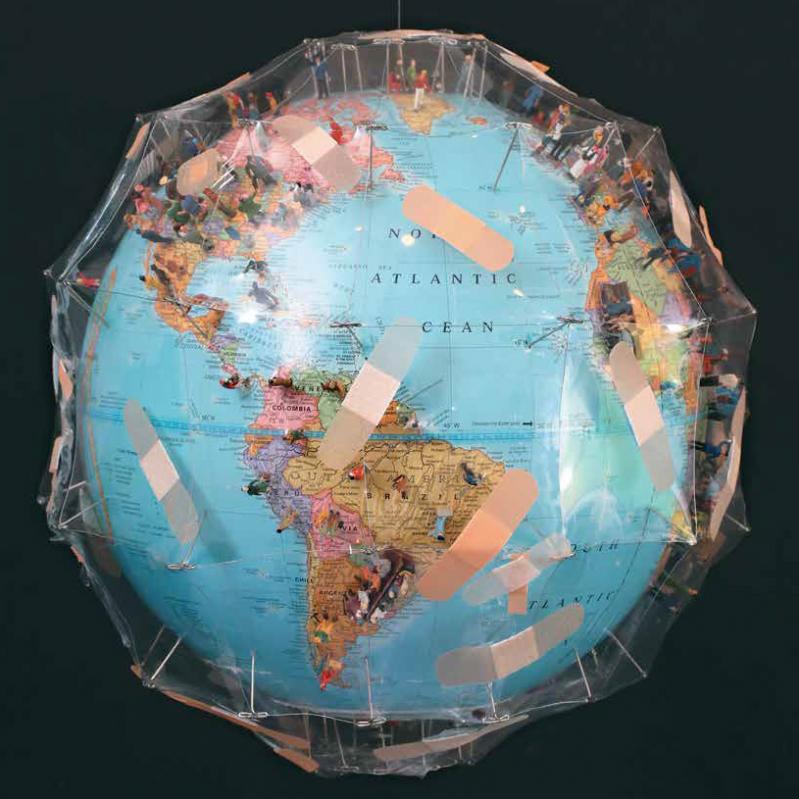"Why bother?"
Michael Pollan's question in a New York Times Magazine article in 2008 captured America's intransigence — amnesia — about combating climate change. Our lack of urgency. At that point, we were two years into a 10-year deadline to reverse carbon emissions lest our overheating planet reach an unrecognizable point of no return.
Eleven years later, the planet is warming faster than predicted, oceans are acidifying and rising, glaciers melting, species dying off at alarming rates, and we are still trying to kick-start a global campaign to reverse man's death sentence on nature as we know it.
What we can do — change our light bulbs, as Al Gore urged us? — does feel minuscule in the face of the magnitude of the problem.
"Nothing I do will make an iota of difference," said a Sagaponack friend who has the wherewithal to install solar and geothermal, drive electric cars, switch his landscape care to electric, plant a garden, recycle, reuse, and reduce his consumption . . . all of which he mostly ignores.
"All the good of those East Hampton wind turbines will be wiped out by one new office building in Dubai," he continued.
Plus, he said: "Really? The seas are rising, the end is nigh, and you're telling me to switch out my light bulbs?"
So why bother, indeed? Well, because we on the South Fork of Long Island are in a unique position to lead on climate change.
For one thing, there are so many rich people here, and rich people pollute way more than anyone else on Earth. The very definition of wealth is that they (we) have what so many others do not have: the great privilege of choice. In this case, it's the choice to actually do something about climate change.
By some estimates, the world's wealthiest 10 percent cause 50 percent of global emissions and the wealthiest 1 percent as much as 30 times (some estimates say more than 100 times) than the poorest half of the human population.
But we all have a role to play.
The reality is that life on Earth has to change for all of us. Waiting around for technological solutions, or for the government to do something on a grand scale, is not going to save us soon enough. Waiting just indicates that, individually, we're not serious about our concern for the planet or our children's future. We do need institutional-driven transformation, but that won't happen without individual change. That is, action from everyone.

So what does a climate-change to-do list look like? We are barraged with suggestions from all sides. There are so many things we know we need to do, as a society and as individuals: switch to electric everything (from power tools to cars and public transportation); utilize non-fossil-fuel sources of energy to power our lives (from geothermal to micro-grids, tidal to solar); protect indigenous populations; empower and educate women (yes, this leads to lower carbon emissions); insulate our homes; plant trees; compost, eat less meat — or, better yet, no meat. . . . All these are among the steps that are needed to reverse man's carbon footprint.
But where do we start? Here are a few concrete first steps, specific to where we live and where we are at this moment:
1. Take the Project Drawdown quiz. It was published by CNN online in April, and it will bring some clarity on how much you do or don't know about practical, real-world climate-change action.
Google "Project Drawdown" and "quiz" and "CNN" and it will pop up.
2. Do no harm. Live every day with that in mind: Am I doing no harm? All of us go through our days thinking we do little harm. But we do. All the time. Once we recognize our personal connection to what is happening to the planet, it is harder to turn away.
3. Commit to doing just one thing. If enough people bother to take action, we begin to influence each other in a chain reaction. Markets for all manner of green products and alternative technologies will prosper and expand. (Consider the market for hybrid cars or rooftop solar, for example.) As Michael Pollan says, "Driving an S.U.V or eating a 24-ounce steak or illuminating your mansion like an airport runway at night might come to be regarded as outrages to human conscience. Not having things might become cooler than having them. And those who do change the way they live would acquire the moral standing to demand changes in behavior from others — from other people, other corporations, other countries."
4. Use those bottle-recycling machines — you know the ones outside supermarkets, like the Amagansett I.G.A.? They're the best way to ensure that your bottles are actually being recycled. Plus, you get a nickel for every bottle. If a nickel doesn't mean much to you, collect them in a jar and donate to them to a charity that plants trees (planting trees is another positive step in the fight).
5. Go solar: Home and office electric use are huge sources of carbon emissions. The best way to reduce your footprint and cut utility power costs is to install solar systems on your own turf. Potentially, if you borrow to install your system, you will have no utility costs within seven to 10 years of a proper installation, depending on the size of the system. Solar needs to go where power is used: atop the very homes and garages that are drawing the power, atop businesses and shopping centers and their adjacent parking facilities (not only generating power but shading the vehicles below). State and federal financial incentives are shrinking but the financial payoff remains quick
East Hampton officials have undertaken a significant campaign to switch to an electric fleet and build solar wherever they can. The sooner the better. Municipalities need to do everything possible to incentivize local solar. We cannot let these efforts turn into another NIMBY situation. You don't like the aesthetic appeal of a solar-panel roof or parking lot? Suck it up. We made this bed, now we have to lie in it.
6. Get a dump sticker. If you contract with a garbage hauler — and most South Fork residents do — chances are slim that all the recyclable materials in your waste stream are truly being recycled: cardboard, probably, if it's clean; the rest probably goes into a hole somewhere off the island. The reason? Markets have collapsed for recyclable materials
Dirty co-mingled waste picked up by carters usually gets thrown out, while material brought by the homeowner to the transfer station actually does get recycled.
So, if you self haul, good for you. And if you contract with a carter, discuss the issue with them: Some — Go Green and Winter Brothers, among others — offer pick up of separated recyclables, which are more likely to actually go where they need to go.
7. Mend and make do. Fix things. Stop throwing out and buying new (whether it's cars, boats, TVs, kitchen appliances, or clothes).
8. Replace leaky fridges and air-conditioners. Because, news flash: Leaky old appliances can emit hydrofluorocarbons, and the capacity of hydrofluorocarbons to warm the atmosphere is thousands of times greater than that of carbon dioxide. Phasing out H.F.C.s would do more to prevent global warming than any other action. Refrigerants give off emissions during production, refilling, and service, plus when they leak — but their damage is greatest at the point of disposal.
9. Switch to a heat pump to control your house's interior temperature. Heat pumps powered by renewable energy could eliminate almost all emissions associated with traditional air-conditioning systems, according to some sources. For this reason (and because heat pumps increase your electric use), PSEG Long Island offers modest rebates of $175 to $450. It's better than a kick in the pants, right? An ideal setup, with virtually zero emissions and no utility bill, would be on-site solar paired with heat pumps.
Heat pumps do have their flaws: Most use refrigerants, which — well, see above. And you might need a backup furnace for very cold nights. But still.
10. Insulate and reinsulate. To get free home energy-use audits, go to Energize East Hampton (energizeeh.org).
While you're at it, ask PSEG about the web-enabled Nest thermostat, which they will ship and install free. It turns off your A.C. when you aren't home and they'll actually send you a check — $250 to $500 — for installing it. If your house will be unoccupied for the off-season, consider a smart thermostat and a timer on your safety lighting, too.
11. Rethink the perfect lawn. A nitrate-fertilized, monochromatic- green, overwatered lawn is not a sign of a healthy lawn any more than a chemically bulked-up body is a sign of a healthy human. Over-fertilizing has become a curse on the land — spurring fish kills and creating toxic, oxygen-depleted ponds and bays. (See: the recent crisis at Georgica Pond.) Gases created from nitrate fertilizers are massive contributors to atmospheric warming.
So, let your lawn become a meadow. The benefits are limitless: more birds, more bees, more life. No noisy, costly, carbon-spewing mowers. If you must mow, use an electric mower; there are several local lawn-mowing contractors who use them nowadays.
If you want advice on how to manage your garden and lawn without doing any harm, ask professionals who have no vested interest in the sale of mowing, clipping, blowing services, and the application of chemical fertilizers and pesticides. Check out perfectearthproject.org.
And, while we're on a roll here: Unless you're having a nighttime garden party, kill the landscape lights.
12. Stop wasting water. Don't irrigate as much. Your garden probably doesn't need it, and if it does, plant things that require less water to begin with. The aquifer can use the water. What's more, it takes energy to get that water to you.
13. Stop striving for the manicured Hamptons- hedge look. Trim your privet once a summer. Let it go to flower! Natural privet is stunning, and fragrant, and less expensive than keeping your privet looking like it's always just been to the barber. Save the energy!
14. Use L.E.D. light bulbs. Yep. It's not a waste of time. They are indeed more expensive, but they use 90 percent less electricity to produce the same amount of light and they last far longer. Change every bulb in the house.
15. Turn off the ignition when waiting at the Jitney stop or post office. Idle less, or not at all. Leaving your car running while you run into the store or watch the sunset from the front seat at the beach for no other reason than you want to leave your can running is wasteful, polluting, and noisy. And there's no benefit from a mechanical standpoint; just ask your mechanic. (Shielding kids or pets from boiling heat or freezing cold is another matter, obviously.)
16. Avoid buying single- serve snacks and drinks. Manufacturing plastic, glass, and cans sucks up energy. We need to reduce the manufacture of these things — and we need to stop polluting oceans and beaches with single-use water bottles. Carry a water bottle.
17. Always keep shopping bags in the trunk of your car. Citarella is working a loophole in the plastic- bag ban in East Hampton and Southampton, arguing that their bags are reusable. Fine, reuse them if you shop at Citarella.
18. Get into frugality. Being frugal is cool. Eco virtue is cool. Small is cool. You may resist it with every fiber in your being, but mom was right: Less really is more.
19. Stop shopping. As far as possible. It's a huge lifestyle change for most of us, but we need to buy less. Seriously. The United States, China, and India are the world's biggest carbon emitters — but India and China are at the top of that list largely because they are the manufacturing hubs for the United States and Western Europe. It is our demand that generates that pollution.
And, the demand is immense: More than two-thirds of our economy is consumer spending. Do we really need so much stuff? If you need strength to curb your Amazon habit, visit youtube.com and view the Rev. Billy and his Stop Shopping Choir as they sing What Would Jesus Buy?
20. Clean your plate, kids — and compost. It's estimated that a third of the food produced worldwide does not get consumed, and food waste is a significant contributor to carbon emissions.
Production, packaging, water use, transportation, and disposal all contribute to the problem. Much of that waste is beyond our control — food that goes unsold at supermarkets, for example — but consumers have an important role to play, too. It's simple: Eat everything you buy. Compost your table scraps, at home or at the dump.
21. Speak up. Don't be shy. We need to start demanding action from the businesses we frequent. There's no time left to be coy or embarrassed about walking the walk. Tell the barista, "No lid, please" — but also ask to talk to the owner or manager about flipping coffee shop culture on its head: Hot and cold drinks should only come with a lid if a customer requests one. Bring your own cup, cutlery, and plates to the office, too.
Although plastic is everywhere, it has reached the end of its design lifespan. Its manufacture is polluting the atmosphere and its waste is polluting our land and our oceans. Let businesses know that you are driving plastic from your life. Feel awkward about going all eco-warrior in public? Get over it.
22. Put your legislators on speed dial. Hold their feet to the fire. Demand that they address this colossal crisis and devote a significant portion of their civic lives to finding ways to cut energy use with municipal and public L.E.D. lighting, bike infrastructure, micro- grids, grid flexibility, and so on. Ask them to fight for the state solar subsidies that are vanishing.
Push back on the Trump administration's efforts to increase oil, gas, and coal production while slashing programs for renewable and clean-energy.
Also, call your congressional representatives and urge ratification of an international agreement — already affirmed by more than 50 other, saner, nations — that is kicking in this year and that begins to phase out all refrigeration and cooling systems that emit hydrofluorocarbons (see above).
23. Care. This one isn't local, it's universal. We have a moral imperative to do something beyond just giving to charities, spending on good businesses, and voting. Turning away from everything that's a downer these days — politics, gun violence, the impeachment hearings — is a modern-day curse. Caring about your neighbors, your church, the future, our schools, our government, the world, the future of the planet — caring — is the definition of being American

